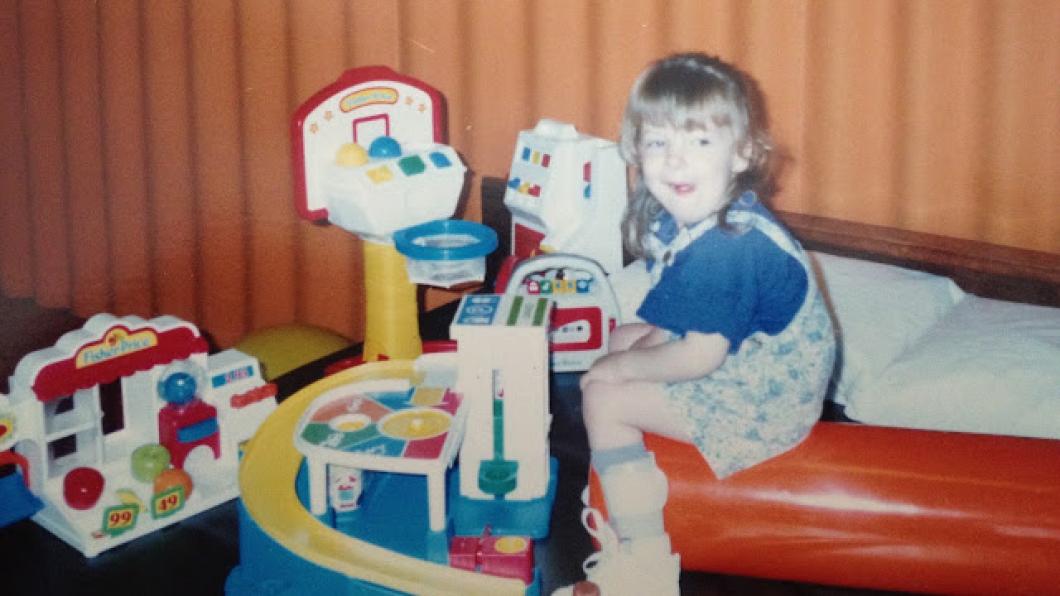
'I wish [disabled] dolls existed when I was a kid'
By Jessica Geboers
When I was little I pushed my red and blue kitchen booster seat around the floor on my tall knees, pretending it was a wheelchair for my doll. Like many kids, I played house with dolls, often pretending I was the mom and they were my children. I can’t remember if using the booster as a wheelchair was my way of compensating for the lack of disability representation in my toys. But maybe it was. Kids act out what they know. It was perfectly normal for me, a child with cerebral palsy, to pretend I was the mother of child with cerebral palsy. And, for lack of a more accurate option, I had to use my imagination.
There aren’t many toys that depict the story of a person with a disability. However, all minorities have struggled to get representation from the toy industry.
There was Share A Smile Becky, a Barbie I had in my vast 1990s collection with a pink and purple wheelchair with sparkly wheels.
Her unfortunate title aside, I remember thinking it was cool to have a Barbie that reflected at least part of my reality. However, her time on store shelves was short lived and she’s since been discontinued.
Some progress in diversity is being made. Mattel announced last month that they’re introducing 23 Barbies with different eye colours, hair colours, skin tones and face shapes. Until now, most Barbies were blonde. Unfortunately Barbie’s skinny body shape, which has been shown to be anatomically impossible, remains unchanged. Most girls and women, including those with a spectrum of body sizes and abilities, don't see themselves reflected in these dolls.
Cue the Toy Like Me campaign, which debuted in April. This Facebook and Twitter initiative was started by three British women: journalist Rebecca Atkinson, who’s deaf and visually impaired; Melissa Mostyn, a deaf writer whose daughter has cerebral palsy; and Karen Newell, a former play consultant whose son is blind. They're asking social media users to join the campaign by sharing images of toys, often handmade or altered, “that reflect disability positively,” as well as letters from children asking the toy industry to create “toys like them” using the hashtag #ToysLikeMe.
“When I was growing up, I never saw a doll like me,” Atkinson said. “I had two hearing aids. In the real world, there were people like me. In the doll world, I didn’t exist. What does that say to deaf and disabled children? That they aren’t worth it? That they’re invisible in the toys they play with? That they’re invisible in society?”
A month later Makie Lab, a 3D printed, made-to-order doll manufacturer out of London, England, answered the call by creating three dolls with visible disabilities or differences: one has vision loss and uses a cane, another comes with hearing aids or a cochlear implant, and the final one has a red facial birthmark. “It’s a pretty even race between the three, but Hetty (with hot pink hearing aids) is leading [sales] right now,” the lab told me in an e-mail.
“It’s fantastic that our supercharged design and manufacturing process means we can respond to a need that’s not met by traditional toy companies,” said Matthew Wiggins, chief technology officer of Makie Lab. “We’re hoping to make some kids—and their parents—really happy with these inclusive accessories.”
Judging by consumer comments on the Makie website, many are happy with the dolls that include disability storylines. I'm also happy. I wish these dolls had existed when I was a kid.
An argument can be made that it’s up to parents—not a toy—to help a child with a disability feel comfortable and confident. But I think these dolls are a helpful tool. And they’ll broaden the awareness of other children and families, too. After all, you can’t adjust to something you’ve never seen or played with.
